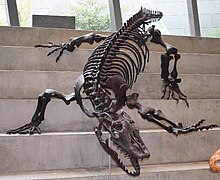
Back Reuse-akkedis Afrikaans ورل سهوب Arabic Мегалания Bulgarian Varanus priscus Catalan Varanus priscus CEB Varanus priscus Czech Megalania German Varanus priscus Spanish Varanus priscus Basque بزمجه باستانی Persian
| Megalania Temporal range: Pleistocene,
| |
|---|---|

| |
| Megalania skeletal reconstruction on Melbourne Museum steps | |
| Scientific classification | |
| Domain: | Eukaryota |
| Kingdom: | Animalia |
| Phylum: | Chordata |
| Class: | Reptilia |
| Order: | Squamata |
| Family: | Varanidae |
| Genus: | Varanus |
| Species: | †V. priscus
|
| Binomial name | |
| †Varanus priscus | |
| Synonyms | |
| |
Megalania (Varanus priscus) is an extinct species of giant monitor lizard,[1] part of the megafaunal assemblage that inhabited Australia during the Pleistocene. It is the largest terrestrial lizard known to have existed, but the fragmentary nature of known remains make estimates highly uncertain. Recent studies suggest that most known specimens would have reached around 2–3 m (6.6–9.8 ft) in body length excluding the tail, while some individuals would have been significantly larger.
Megalania is thought to have had a similar ecology to the living Komodo dragon (Varanus komodoensis). The youngest fossil remains of giant monitor lizards in Australia date to around 50,000 years ago.[2] The first indigenous settlers of Australia might have encountered megalania,[3] and been a factor in megalania's extinction.[4][2][5] While originally megalania was considered to be the only member of the titular genus "Megalania", today it is considered a member of the genus Varanus, being closely related to other Australian monitor lizards.
- ^ a b Owen R. (1859). "Description of Some Remains of a Gigantic Land-Lizard (Megalania Prisca, Owen) from Australia". Philosophical Transactions of the Royal Society of London. 149: 43–48. doi:10.1098/rstl.1859.0002. JSTOR 108688.
- ^ a b Price, Gilbert J.; Louys, Julien; Cramb, Jonathan; Feng, Yue-xing; Zhao, Jian-xin; Hocknull, Scott A.; Webb, Gregory E.; Nguyen, Ai Duc; Joannes-Boyau, Renaud (2015-10-01). "Temporal overlap of humans and giant lizards (Varanidae; Squamata) in Pleistocene Australia". Quaternary Science Reviews. 125: 98–105. Bibcode:2015QSRv..125...98P. doi:10.1016/j.quascirev.2015.08.013.
- ^ Hideaki Kato (2021). 図解大事典 絶滅動物. 新星出版社. p. 229. ISBN 9784405073432.
- ^ Dick, Taylor J. M.; Clemente, Christofer J. (2016-02-18). "How to build your dragon: scaling of muscle architecture from the world's smallest to the world's largest monitor lizard". Frontiers in Zoology. 13: 8. doi:10.1186/s12983-016-0141-5. ISSN 1742-9994. PMC 4758084. PMID 26893606.
- ^ "Wildfacts - Megalania, giant ripper lizard". BBC. 2008. Archived from the original on 2011-12-27. Retrieved 2012-03-22.